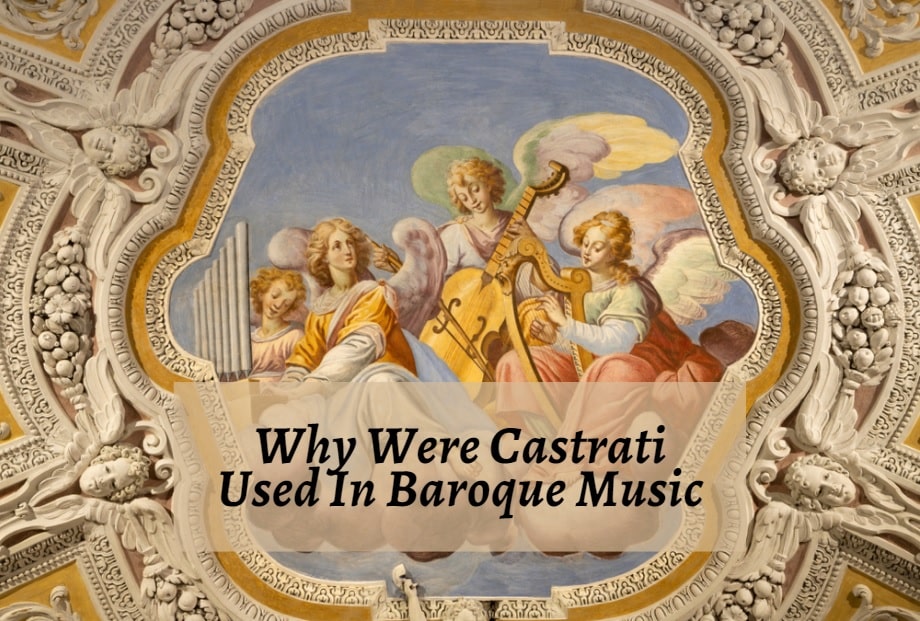
This, perhaps, is not a topic for the faint-hearted. From the word, you may already have guessed what this means in terms of physical alteration, even mutilation. There was a time reaching as far back as the third century when this practice was alarmingly common.
If you’re not familiar with the world of the castrati, and their place in the classical music world, then this article is for you.
Why Were Castrati Used In Baroque Music
It is thought that the male castrati were first used in the early Byzantine churches. As time progressed, the idea travelled westward, finding a new domicile in Sicily and, in particular, the choirs of the Roman Catholic Church.
The operation to manufacture castrati did involve the removal of the boy’s testicles. This cruel practice occurred before the boy’s voice broke, and as such, it was often common to find boys as young as eight subject to this procedure.
In the late Renaissance and into the Baroque era, women were not generally permitted to take part in religious choirs or to perform on stage. This left the highest voice of those ensembles absent.
There was the option to employ male falsetto voices, high counter-tenors, or children, but such was the remarkable timbre of the castrati that even the Pope by 1625 had changed his mind about banning the practice of castration.
The ‘Papel Choir’ soon boasted an impressive array of castrati or ‘natural sopranos’. (If you want to hear the unique sound of the castrati voice, follow this link to what I believe is one of the very few actual recordings of castrati.
The effect of castrati becoming a feature of the Papel choir meant that other choirs would have made every effort to keep up with the trend. Before many years had elapsed, the castrati were the dominant voice and, from around 1620, extensively used in many forms of music, including opera.
There was an additional factor at play during the early part of the 17th Century. Italy was in the grip of a deepening economic slump. This may have forced some parents to have their sons undergo this operation in the hope that they would become wealthy.
Unfortunately, even if a boy does endure the procedure, there is no guarantee that their voice will develop into that of a castrati singer. Those who did make the grade would inevitably devote their lives to a church chosen for them.
For the lucky few who not only had the coveted purity of voice and years of skilled vocal training behind them, their lives were one of privilege, admiration, and fame.
It is not a quantum leap to see how easily the fashion for the castrati dovetailed into secular as well as sacred Baroque music. Opera, which developed as a musical art form during the Baroque, took hold of this trend, and the popularity of the castrati was assured.
What is loosely termed The Golden Age of the Castrati was born. One of the most celebrated castrati from that period was a singer called Francesco Bernardi. Of Italian birth, he became a pop star of his age.
He played leading roles in many of Handel’s operas, including ‘Rodelinda’. Audiences heard a voice that was unrivalled in purity and clarity. Bernardi’s diction was superb, and his command of the expressive qualities of opera was astonishing.
Composers like Handel quickly became aware of the technical capabilities of the best castrati. You can listen to ‘Rinaldo’ and ‘Giulio Cesare in Egitto’ by Handel, which present the castrati in major roles.
In a castrati performer, not only did you have a singer who sounded somewhere between a mezzo-soprano and a boy soprano, but you had the lung power of a fully-grown man.
These physical characteristics made the castrati’s voice able to sound effortlessly above a Baroque orchestra and chorus. The castrati achieved an almost Holy status in music.
The role of the castrati changed over time. Initially, they may have been cast as female characters. Their appearance, after all, was, to all intents and purposes, that of a woman.
This led to some ridicule as these men appeared in women’s clothes and then sang in a voice that the uninitiated may have thought was comical. This did not endure. Before long, the castrati were singing the roles of heroes.
Francesco Sacrati, in his opera of 1641, ‘La Finta Pazza’ offers one of the first signs of that key change in the fortune of the castrati.
Composers took the opportunities given by these new superstars to write incredibly challenging passages of music. Long-held notes together with richly melismatic phrases were characteristics of many pieces composed to the specific talents of these gentlemen.
Their virtuosity became a spectacle, with few able to match their astonishing levels of skill, stamina, and fluency. Looking forward, these florid technique displays paved the roadway to the bel canto singing style that Donizetti composed so well.
As the Baroque Era began to fade, so too did the dominance and popularity of the castrati. Culturally things rarely remain static for long. Instead, they slowly evolve as society’s tastes change and a new era begins.
Even though the castrati enjoyed immense popularity during the Baroque era, they did continue into the Classical era too. WA Mozart, for example, also liked the unusual sound and expressive potential of the castrati.
He composed seven operas with this voice definitely in mind. Two of the more widely known include ‘Idomeneo’ and ‘La Clemenza di Tito’. Other Classical composers also wrote for the castrati, including notable arias by Thomas Arne and JC Bach.
We will never truly hear the voice of the castrati, and for good reasons. There is little doubt that the vocal qualities of these unfortunate stars of their day inspired some of the world’s most stunning vocal music.
The beauty and distinctiveness of each of these castrati must have been a wonder to hear and understandably stood out as a feature of the Baroque period.
